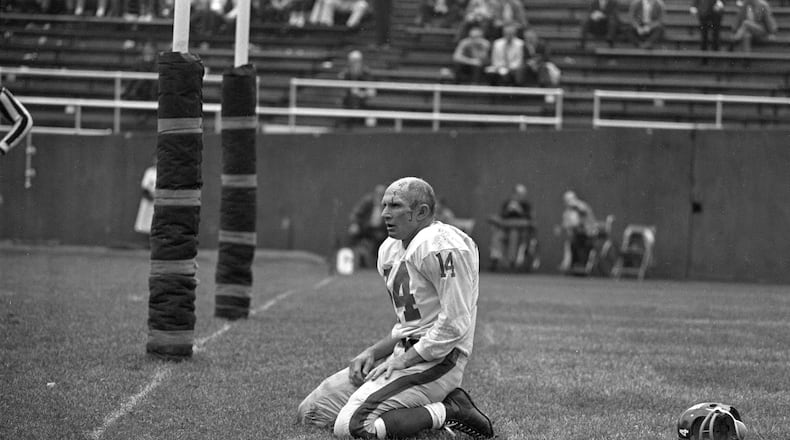Sometimes the difference between fame and obscurity is 100th of a second.
Consider two photographs, almost identical, of an agonizing moment in sports history.
Y.A. Tittle, 38 years old, playing his last season with the N.Y. Giants, had just been sacked by Steelers defensive end John Baker.
On his knees in the turf, blood trickling down his forehead, Tittle stares with stunned dismay at the end of a career. The moment produced one of the most enduring images in sports photography, which earned a place in the Pro Football Hall of Fame.
That image emerged again in the fall of 2009 when Tittle published his autobiography, and again this week with the death of Y.A. Tittle.
But who was the photographer? Two shooters stood shoulder to shoulder that afternoon and snapped similar frames.
The photo at the top of the page was shot by Dozier Mobley, a Georgia native and young sports photographer, working the Steelers-Giants game in 1964 for The Associated Press. Another photographer, Morris Berman, took a similar image while covering the game for the Pittsburgh Post-Gazette.
Berman’s editor decided against running the image because of its lack of action. Mobley sent his film to his editors, who put the picture out on the wire to hundreds of newspapers. And Mobley went on to the next job.
Photo honored
According to The New York Times, which took note of Berman’s passing when he died in 2002, Berman’s image came to light when he entered it in a contest later that year, and it won a National Headliner award for best sports photograph in 1964. It went on to be singled out by Sports Illustrated and other publications, and is generally the image reprinted most often.
Credit: 1964 Mobley family photo
Credit: 1964 Mobley family photo
But occasionally Mobley’s image surfaces. It’s on the back cover of Tittle’s book, “Nothing Comes Easy: My Life in Football,” published in September, 2009. In his chapter, “The End of an Era,” Tittle writes that Berman took the photo. But the publisher credits The Associated Press. In other words, it’s Mobley’s photo on the back of the book.
“I don’t think most people are aware that there are two versions of it,” said Chuck Zoeller in 2009, former head of the AP’s photo library. “Frequently, one photo is mistaken for the other, and vice versa.”
Julian Cox, former curator of photography at the High Museum in Atlanta, said in 2009 that photo credits in that era were often jumbled, and that AP photographers had less control over their own images than other journalists. “Once that negative is put into a manila envelope and mailed, they’d probably never see that negative again.”
In 2009 Pittsburgh Post-Gazette photo editor Andy Starnes said he didn’t remember the Mobley photograph, but added that a third photographer, Don Stetzer, shooting for the Pittsburgh Press, also shot a similar photo that is equally unheralded.
Stetzer, retired and living near Pittsburgh in 2009, said it’s no big deal. “It was just another day at the office.”
Dozier Mobley, 75, died Nov. 10, 2009, in Jefferson, Ga., with little national notice. He grew up in East Atlanta and became a photographer at a Thomasville newspaper right out of the Army. After a decade as a wire service photographer, with time in Pittsburgh, he began shooting for NASCAR and worked the racing circuit for 30 years.
The Georgia-born photographer never had a copy of his most famous picture until his son, Mark Mobley, acquired one for him.
“I was just floored,” said Mark Mobley in 2009, a former Athens resident. “Here it is one of the most famous sports images of the 20th century, and the guy who took it doesn’t have one.”
About the Author
Keep Reading
The Latest
Featured





